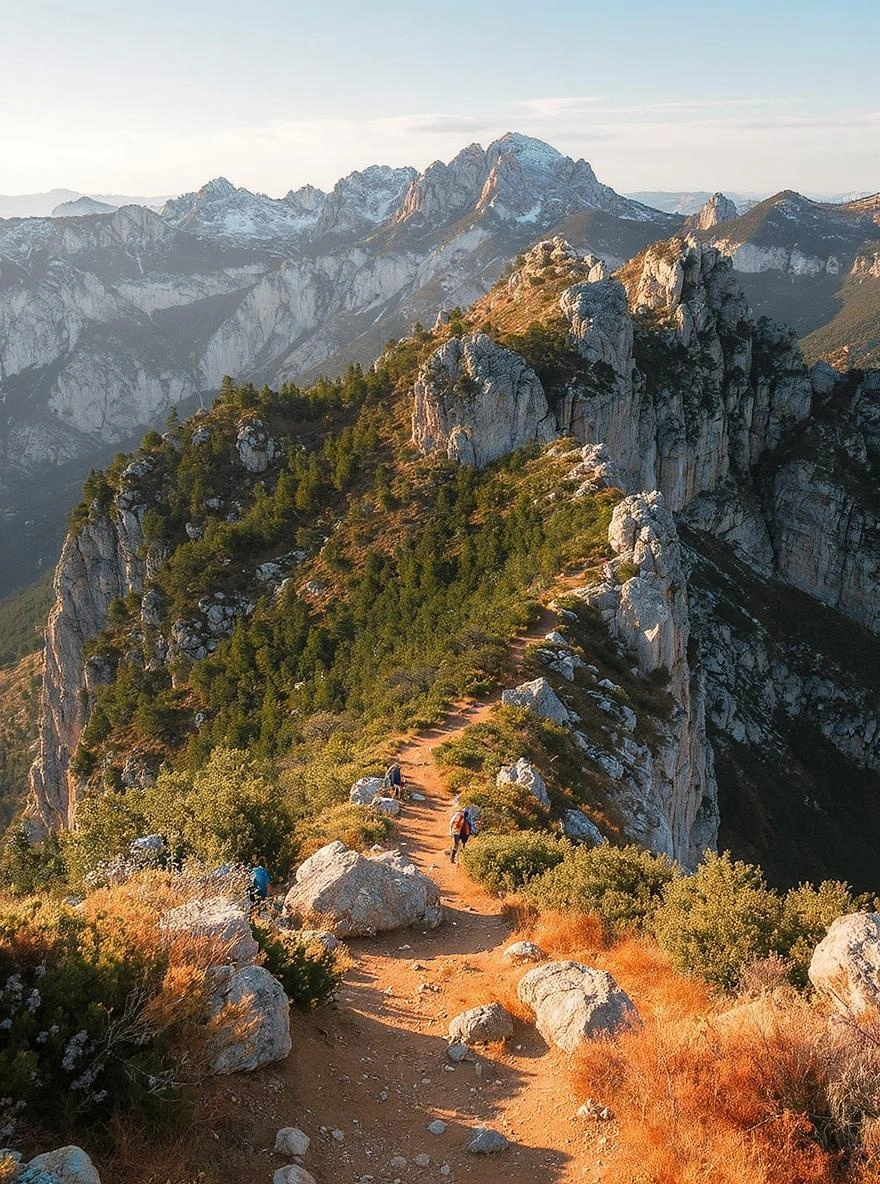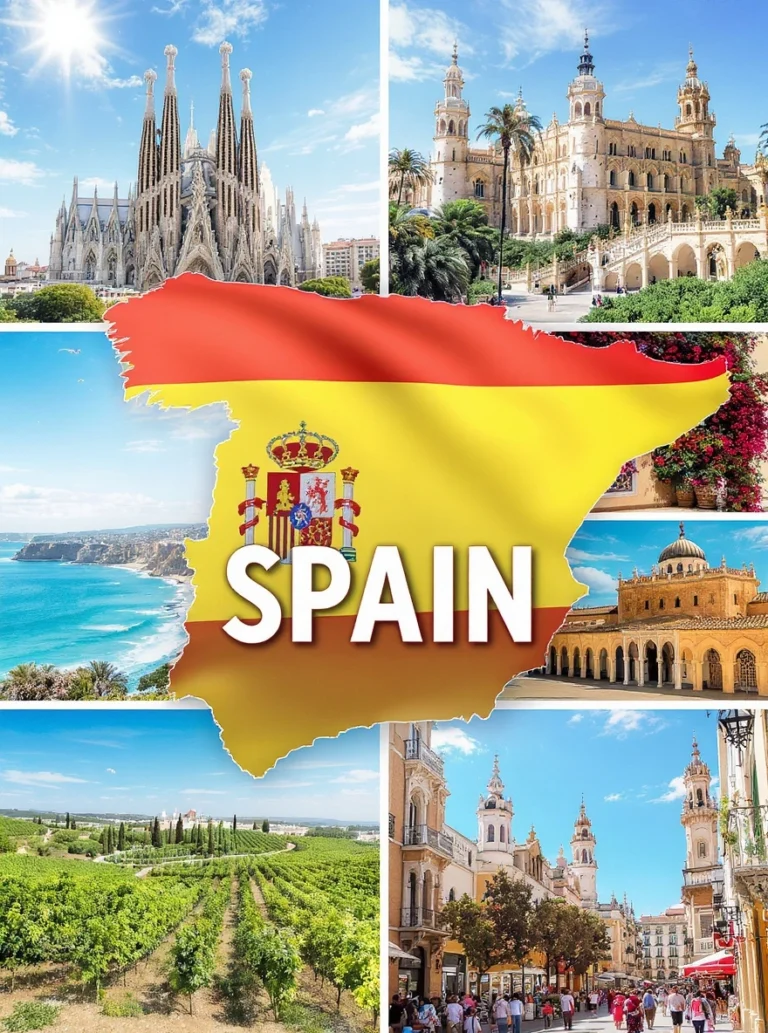Hiking in Spain: Unveiling Epic Trails, Hidden Gems & Essential Tips for Every Adventurer
Table of Contents
Welcome to Spain, a Hiker’s Paradise!
Beyond the tapas and sun-soaked beaches that Spain is famous for lies a hiking wonderland that’ll take your breath away. Did you know Spain is Europe’s second most mountainous country? That’s right! This diverse landscape offers some of the most incredible hiking experiences you could imagine.
Whether you’re dreaming of conquering majestic peaks, wandering through medieval villages, or strolling along dramatic coastlines, Spain has a trail with your name on it. This guide is your one-stop resource for planning an unforgettable Spanish hiking adventure, covering everything from iconic pilgrim routes to hidden mountain gems that even locals don’t know about.
What makes Spain truly special for hikers is its incredible year-round potential. Thanks to its varied climate, you can find suitable hiking conditions somewhere in the country no matter what month it is. Add in rich history that spans millennia and natural landscapes that range from snow-capped mountains to volcanic islands, and you’ve got a hiking destination that’s hard to beat anywhere in the world.
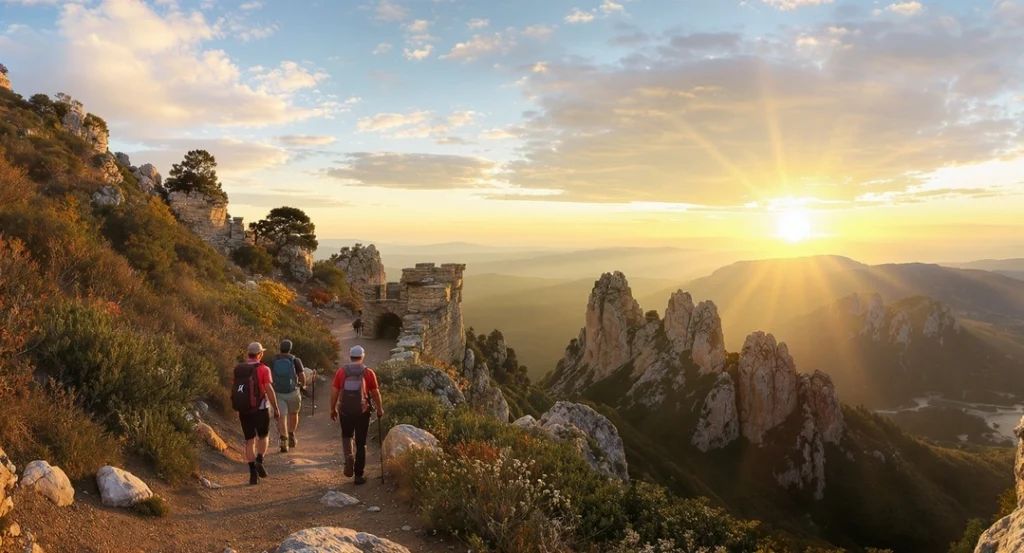
Why Spain is a Hiker’s Dream Destination
Diverse Topography
Spain’s landscape is like a hiker’s buffet – there’s something for every taste and ability level. In the north, the mighty Pyrenees form a natural border with France, offering alpine experiences that rival Switzerland but with fewer crowds and lower prices. Down south, the Sierra Nevada boasts mainland Spain’s highest peak (Mulhacén) where you can potentially see Africa on clear days!
Don’t miss the dramatic limestone formations of the Picos de Europa, the rolling Cantabrian Mountains, or the otherworldly rock spires of Montserrat that look like they belong in a fantasy film.
Coastal Beauty
Spain’s 3,000+ miles of coastline aren’t just for beach-goers. Hikers can enjoy rugged cliff paths with Mediterranean views, hidden coves accessible only by foot, and stunning coastal routes that combine mountain and sea vistas. The Costa Brava’s ancient paths and the dramatic Basque coastline offer some of Europe’s most spectacular coastal walking.
Unique Terrains
Where else can you hike across desert landscapes in the morning (Tabernas Desert), explore ancient Roman gold mines at midday (Las Médulas), and wander through glacial valleys by evening? Spain’s geographical diversity means you’ll never get bored, with volcanic moonscapes in the Canaries, lush river gorges in the north, and everything in between.
Favorable Climate for Year-Round Hiking
Spain’s varied climate is a hiker’s dream. When northern Europe is freezing, southern Spain and the Canary Islands offer perfect hiking weather. In summer, when the south bakes, the northern mountains provide cool relief. With some planning, you can hike in Spain any month of the year – something few European countries can claim!
Rich History & Culture on the Trails
What makes hiking in Spain extra special is how culture and nature intertwine on the trails. Many routes follow ancient paths used by Romans, Moors, or medieval pilgrims. You’ll stumble upon crumbling castles, remote monasteries, and villages that seem frozen in time. It’s like hiking through an open-air museum where each step reveals another chapter of Spain’s fascinating story.
The Best Hiking in Spain: A Curated Collection
Iconic & Must-Do Trails (For Every Bucket List)
1. Camino de Santiago (The Way of St. James)
Location: Northern Spain, ending in Santiago de Compostela, Galicia
Key Features: This isn’t just a hike; it’s a life-changing journey. The Camino is a network of ancient pilgrim routes stretching across Europe, all leading to Santiago de Compostela where St. James’s remains are said to be buried. The most popular route, the Camino Francés, crosses the magnificent Pyrenees before winding through medieval towns, vineyards, and the rolling landscapes of northern Spain.
Difficulty: Varies by route, but generally “Intermediate” for multi-day hikers
Distance & Duration: The Camino Francés is about 500 miles (780km), typically taking 30-35 days to complete, though many people just do sections
Best Time to Hike: May to October offers the best weather, but September is ideal (warm days, cool nights, fewer crowds)
Unique Tips: You’ll need a “pilgrim’s passport” (credencial) to stay in the special pilgrim hostels and to receive your Compostela certificate. Don’t miss the tradition of carrying a stone from home to place at the Cruz de Ferro (Iron Cross).
Accommodation/Starting Point: Many start in Saint Jean Pied de Port on the French border, but you can join anywhere. The historic Hostal Reis Catolicos in Santiago makes for a luxurious end to your journey!
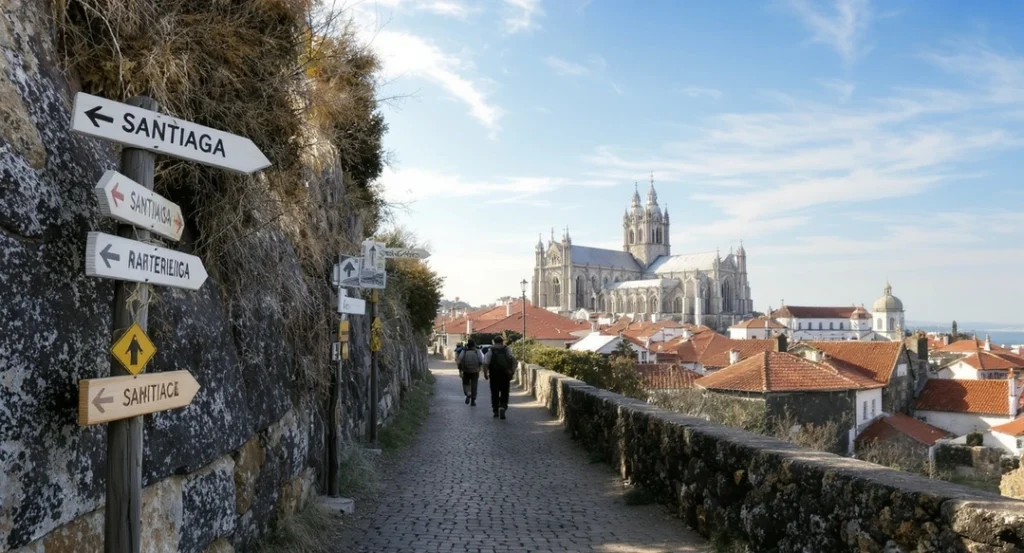
2. Caminito del Rey
Location: El Chorro gorge, Málaga province, Andalusia
Key Features: Once dubbed the “world’s most dangerous walkway,” this restored path clings to sheer cliff faces 100 meters above the gorge floor. It’s been safely rebuilt since its daredevil days, but still offers heart-pounding thrills as you walk along suspended boardwalks with nothing but air beneath you.
Difficulty: Moderate – not technically difficult but definitely not for those with a fear of heights!
Distance & Duration: 7.7km (about 5 miles), taking 3-4 hours
Best Time to Hike: Year-round is possible, but spring (April-May) and fall (September-October) offer the most pleasant temperatures
Unique Tips: Book tickets well in advance (€10) as they limit daily visitors. The trail is one-way only, so plan your transport back. Don’t forget your camera – the photo opportunities are incredible!
Accommodation/Starting Point: La Posada del Conde near Ardales is a charming base. The trail runs from Ardales to Alora with shuttle buses connecting the endpoints.
3. Picos de Europa (Cares Gorge Trail / Ruta del Cares)
Location: Northern Spain, spanning Asturias, Cantabria and León provinces
Key Features: Often called the “Divine Gorge,” this spectacular trail was carved into limestone cliffs in the early 20th century to service a hydroelectric canal. The path hugs vertiginous cliff faces with the Cares River roaring far below, while the dramatic peaks of the Picos de Europa tower above. It’s like Spain’s answer to Nepal’s mountain trails but without the altitude issues!
Difficulty: Moderately challenging – not technically difficult but exposed in places
Distance & Duration: 12km (7.5 miles) one-way, taking 4-5 hours
Best Time to Hike: May to October, but avoid July-August when it gets crowded with tourists
Unique Tips: You can start from either Poncebos (Asturias) or Caín (León). I’d recommend starting at Poncebos as you’ll get the steepest climb out of the way early when you’re fresh.
Accommodation/Starting Point: Hostal Poncebos is perfectly positioned at the trailhead in Poncebos, Asturias
4. Montserrat (Sant Jeroni Summit Loop)
Location: Just an hour from Barcelona, Catalonia
Key Features: “Montserrat” means “serrated mountain,” and you’ll see why when you spot its distinctive jagged peaks. This holy mountain is home to a Benedictine monastery housing the famous Black Madonna statue. The hike offers a perfect mix of natural wonder and spiritual significance, with panoramic views across Catalonia from the Sant Jeroni summit (1,236m).
Difficulty: Moderate – some steep sections but generally well-maintained paths
Distance & Duration: Sant Jeroni loop is about 5 miles, taking 3-4 hours
Best Time to Hike: Spring and fall for pleasant temperatures; summer can be hot
Unique Tips: Start early to beat both the heat and the crowds. Take the funicular railway up to Sant Joan for a head start if you want to save energy for exploring the monastery area later.
Accommodation/Starting Point: Stay at Hotel Abat Cisneros right beside the monastery for the full experience
5. Mulhacén (Sierra Nevada)
Location: Sierra Nevada, Andalusia, near Granada
Key Features: Climbing mainland Spain’s highest peak (3,479m) is a badge of honor for serious hikers. From its summit, you can see the Mediterranean Sea and sometimes even Morocco’s Atlas Mountains on clear days. In winter it’s snow-covered, but in summer it’s a challenging but accessible hike.
Difficulty: Hard – high altitude and steep in places
Distance & Duration: The south route from Trevelez is about 18km round trip, taking a full day
Best Time to Hike: July to September when the snow has cleared
Unique Tips: The summer shuttle bus from Capileira makes the hike much more manageable, reducing the ascent significantly. Otherwise, be prepared for a very long day or an overnight at Refugio Poqueira mountain hut.
Accommodation/Starting Point: Granada makes a good base, with buses to the mountain villages of Capileira or Trevelez
6. Mount Teide (Las Cañadas del Teide National Park)
Location: Tenerife, Canary Islands
Key Features: Hiking on Spain’s highest peak (3,718m) feels like walking on another planet. The volcanic landscape of Las Cañadas caldera is otherworldly, with strange rock formations, unique endemic plants, and incredible views above the clouds. The summit cone rises dramatically from the crater floor.
Difficulty: Hard if hiking from the base; Moderate if using the cable car
Distance & Duration: Various routes available; from the cable car top station it’s about 1 hour to the summit
Best Time to Hike: Year-round thanks to Tenerife’s eternal spring climate, but winter can bring snow at higher elevations
Unique Tips: You need a free permit to hike to the summit (book well in advance online). If you can’t get a permit or want an easier option, the spectacular Roques de García trail loops around some of the park’s most striking rock formations without needing a permit.
Accommodation/Starting Point: Stay in Vilaflor (Spain’s highest village) for early access to the park
Hidden Gems & Secluded Adventures (For the Off-the-Beaten-Path Explorer)
7. Sendero Botanico de Hoz de Beteta / Serranía de Cuenca
Location: Serranía de Cuenca Natural Park, Castile La-Mancha
Key Features: This little-known botanical trail takes you through a spectacular limestone gorge where ancient linden trees cling to the rock walls. Wooden walkways guide you along the river where you might spot deer coming to drink.
Difficulty: Easy – suitable for all fitness levels
Distance & Duration: 2.6 km, about 1-2 hours at a leisurely pace
Best Time to Hike: Beautiful year-round, especially magical in autumn when the leaves change color
8. Camino Natural del Rio Guadalaviar
Location: Near Teruel, Sierra de Albarracín area
Key Features: This riverside trail follows the crystal-clear Guadalaviar River through a picturesque gorge. Metal walkways and bridges help you navigate the more challenging sections, and there are lovely picnic spots along the way.
Difficulty: Easy – perfect for families
Distance & Duration: About 7 km, 2-3 hours
Best Time to Hike: Spring and fall offer the most pleasant temperatures
9. Bosque de Carlac Trail
Location: Tiny village of Bausen, Spanish Pyrenees, near the French border
Key Features: If you’re looking for a fairytale forest hike, this is it! The ancient woodland is filled with moss-covered trees, mysterious abandoned houses, and mountain streams. The combination of dense forest and mountain views is rare and magical.
Difficulty: Intermediate – some elevation gain
Distance & Duration: 6.5 km circular trail, 2-3 hours
Best Time to Hike: Late spring for wildflowers or autumn for fall colors
10. The Millenary Olive Trees Route
Location: Canet lo Roig, Castellón province, Valencia region
Key Features: Walking among olive trees that were already ancient when the Romans ruled Spain is a humbling experience. Some of these gnarled trees are over 2,000 years old, their twisted trunks telling stories of centuries gone by. You can even buy oil made from their olives!
Difficulty: Easy – flat terrain suitable for all
Distance & Duration: 5.8 km circular route, about 2 hours
Best Time to Hike: Year-round, but avoid the hottest summer hours
Stunning Coastal Walks (Where the Mountains Meet the Sea)
15. Costa Brava Coastal Path (Camí de Ronda / GR92)
Location: Northeastern coast of Spain, Catalonia
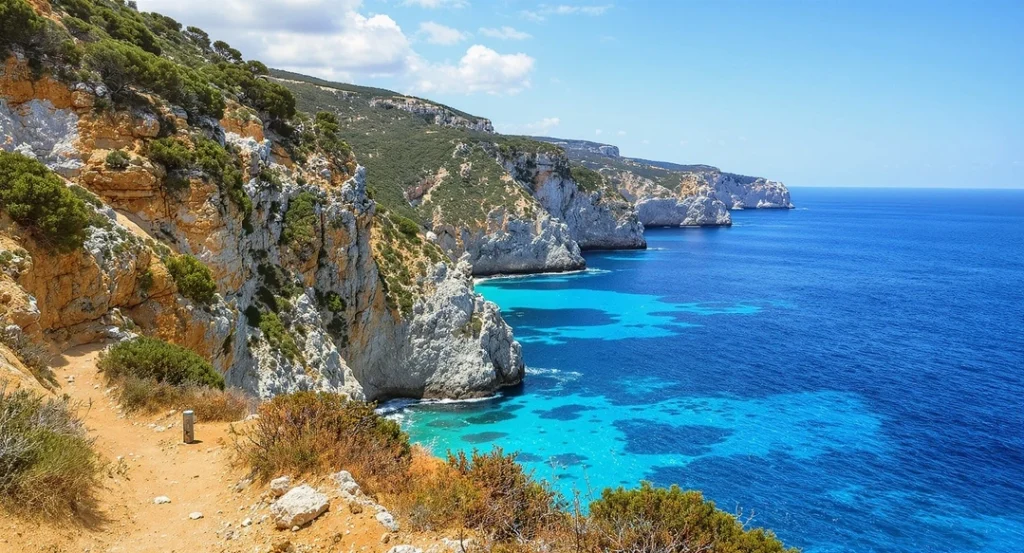
Key Features: This historic path once used by smugglers and coastguards now offers one of Europe’s most beautiful coastal walks. It connects hidden coves with crystal-clear turquoise waters, passes through charming fishing villages, and provides dramatic clifftop views. Every turn reveals another postcard-worthy vista.
Difficulty: Moderate overall, with some challenging sections
Distance & Duration: The full route is over 200km, but it’s easily done in sections
Best Time to Hike: April-June or September-October for pleasant temperatures and fewer tourists
Unique Tips: Bring a swimsuit! You’ll pass countless irresistible swimming spots where you can cool off with a dip in the Mediterranean.
Accommodation/Starting Point: The charming village of Cadaqués makes a perfect base for exploring the northern sections
16. Cavalls Path, Menorca
Location: Encircles the entire island of Menorca, Balearic Islands
Key Features: This coastal path circumnavigates the entire island of Menorca, taking you to pristine beaches inaccessible by car. You’ll discover hidden coves with turquoise waters, ancient watchtowers, and unique ecosystems in this UNESCO Biosphere Reserve.
Difficulty: Moderate to Hard depending on sections
Distance & Duration: 185 km full circuit, typically done in 8-10 days
Best Time to Hike: April-June or September-October for ideal conditions
Unique Tips: Wear sturdy shoes as many sections are quite rocky. Water access can be limited on some stretches, so plan accordingly.
Accommodation/Starting Point: Can Alberti 1740 Boutique Hotel in Mahón makes a luxurious starting point
Family-Friendly Hikes (Adventures for All Ages)
24. Senda del Oso (Bear Trail)
Location: Asturias region, northern Spain
Key Features: This family-friendly trail follows a former mining railway through stunning landscapes. The highlight for kids is seeing the rescue centers for Cantabrian brown bears, where they can observe these magnificent creatures safely. The mostly flat route follows the Trubia River through gorgeous scenery.
Difficulty: Easy – largely flat with good surfaces
Distance & Duration: 22 km total, but easily broken into shorter sections
Best Time to Hike: Spring through fall, particularly beautiful in autumn
25. La Pedriza (La Pedriza-Canto Cochino-Charca Verde route)
Location: Sierra de Guadarrama, near Madrid
Key Features: This granite wonderland just outside Madrid feels like nature’s playground. The unique rock formations fascinate children, and there are small streams and pools (like the famous Charca Verde) where they can cool off in summer. The bizarre rock shapes spark imagination – kids love finding animals and faces in the stones.
Difficulty: Easy to Moderate depending on route
Distance & Duration: Various routes available; the loop to Charca Verde is about 7.5 miles (4 hours)
Best Time to Hike: Year-round, though summer can be hot – go early or late in the day
Planning Your Spanish Hiking Adventure: Essential Tips & Resources
When to Hike in Spain: A Seasonal Guide
Spain’s diverse climate means hiking possibilities exist year-round, but timing matters depending on your destination:
Spring (April-June): Perhaps the best overall hiking season across Spain. Wildflowers bloom, temperatures are moderate, and tourist crowds haven’t arrived. Perfect for Andalusia, central Spain, and mid-elevation trails everywhere.
Summer (July-August): Great for high mountain areas like the Pyrenees and Picos de Europa where snow has melted but temperatures remain comfortable. Avoid southern Spain where temperatures regularly exceed 100°F (38°C). Early morning starts are essential wherever you go.
Fall (September-November): Another golden period for hiking, with stable weather, fewer crowds, and beautiful fall colors in northern regions. The Mediterranean coast and Andalusia are particularly pleasant after the summer heat subsides.
Winter (December-March): The Canary Islands shine as a winter hiking destination with their eternal spring climate. Costa Blanca and southern Spain offer mild winter hiking, while the mountainous north becomes a snowshoeing and winter mountaineering playground.
Essential Hiking Gear Checklist
Footwear: Invest in quality hiking boots with ankle support – Spain’s trails are often rocky and uneven.
Clothing: Layering is key in Spain’s variable climate. Pack quick-dry fabrics, a waterproof jacket (especially in the north), and always bring a sun hat.
Sun Protection: Spain’s sun is fierce – sunscreen, sunglasses, and a good hat are non-negotiable, even in winter.
Hydration: Carry more water than you think you’ll need, especially in central and southern Spain where water sources can be scarce.
Navigation: While popular trails are well-marked, download offline maps using apps like AllTrails or Wikiloc, which are particularly good for Spanish trails.
First Aid: Include blister treatment – nothing ruins a hiking holiday faster than painful feet!
Trekking Poles: Helpful on Spain’s steep and rocky terrain, particularly for descents.
Swimwear: For coastal hikes or routes with river pools – there’s nothing better than a refreshing dip mid-hike!
Safety First: Important Precautions
Heat Awareness: Spain’s summer heat is no joke. Start early, carry extra water, and know the signs of heat exhaustion.
Wildlife Caution: The Cantabrian Mountains and Pyrenees have brown bear populations, while wolves inhabit parts of Galicia and Asturias. They rarely pose danger but educate yourself on proper behavior.
Mountain Weather: Conditions can change rapidly, especially in the Pyrenees and Sierra Nevada. Check forecasts religiously and be prepared to turn back if conditions deteriorate.
Communications: Cell coverage can be spotty in remote areas. Consider renting a satellite communicator for serious backcountry hikes.
Solo Hiking: If hiking alone, always share your route and expected return time with someone reliable.
Understanding Local Regulations & Ethics
Spain’s attitude toward hiking access is generally open, but there are important rules to follow:
Protected Areas: Many of Spain’s best hiking areas are within natural parks or reserves with specific regulations. Research before you go.
Trail Permits: Some popular trails like Mount Teide summit require permits, often available online in advance.
Leave No Trace: Spain’s delicate Mediterranean ecosystems are vulnerable to damage. Pack out all trash and stay on established trails.
Respect Private Property: Some trails cross private land where access is permitted – respect boundaries and close gates.
Fire Restrictions: Summer fire risk is extreme in many regions, with strict prohibitions on open flames.
Getting Around Spain for Hiking
Flights: For international visitors, major gateways include Madrid, Barcelona, Málaga, and Bilbao. Budget airlines connect these to smaller regional airports.
Trains: Spain’s high-speed AVE network connects major cities, while regional trains serve many hiking areas. The scenic narrow-gauge FEVE railway is perfect for northern Spain hiking access.
Buses: ALSA and other companies reach even small villages, though schedules may be limited in rural areas.
Car Rental: For maximum flexibility, especially in remote areas, renting a car is ideal. Many trailheads have dedicated parking areas.
Local Taxis: In hiking-popular regions, taxi drivers often specialize in dropping and collecting hikers – arrange in advance for point-to-point hikes.
Accommodation Options for Hikers
Mountain Refuges: In the Pyrenees and other mountain ranges, networks of staffed and unstaffed mountain huts (refugios) allow for multi-day treks. Book ahead in high season.
Rural Tourism: Spain’s network of casas rurales (country houses) offers authentic accommodation in hiking regions, often with home-cooked meals.
Pilgrim Hostels: Along the Camino de Santiago, special albergues provide budget beds for pilgrims with a credencial (pilgrim passport).
Camping: Options range from full-service campgrounds to wild camping (permitted in some areas but with restrictions).
Paradores: These government-run luxury hotels in historic buildings are often positioned near spectacular hiking areas, offering a splurge option for tired legs!
Beyond the Trails: What Else to Experience in Spain
A Spanish hiking trip isn’t complete without sampling the broader culture:
Gastronomic Adventures: Each region has its culinary specialties – try Asturian fabada after hiking Picos de Europa or paella after a Costa Blanca coastal walk.
Historic Sites: Many trails pass ancient monasteries, prehistoric caves, or Moorish castles worth exploring.
Local Festivals: Time your visit to coincide with Spain’s countless local festivals for an authentic cultural experience.
Urban Hiking: Cities like Barcelona, Granada, and San Sebastián offer fantastic urban hiking with cultural rewards at every turn.
Recovery Days: Spain’s abundant thermal spas (balnearios) are perfect for soothing tired hiking muscles.
Why This is Your Ultimate Spanish Hiking Resource
Spain offers such diversity that you could spend a lifetime exploring its trails and still discover new wonders. This guide combines bucket-list classics with off-the-radar gems that even many Spaniards don’t know about. From family-friendly strolls to challenging mountain expeditions, from day walks to epic multi-week adventures, Spain has it all.
What makes hiking in Spain truly special is the combination of natural beauty, rich culture, excellent infrastructure, and the warm welcome you’ll receive in even the most remote village. The country’s hiking trails tell the story of its fascinating history, diverse ecosystems, and the resilient people who have shaped this land over millennia.
Your Spanish Hiking Adventure Awaits!
From the misty green mountains of Galicia to the sun-baked trails of Andalusia, from the alpine grandeur of the Pyrenees to the volcanic wonderland of the Canaries, Spain offers a lifetime of hiking adventures. Whether you’re planning a dedicated hiking vacation or just want to add a day walk to your Spanish beach holiday, the trails await.
So lace up your boots, fill your water bottle, and hit the trails – Spain’s mountains, forests, gorges, and coastlines are calling. ¡Buen Camino!

